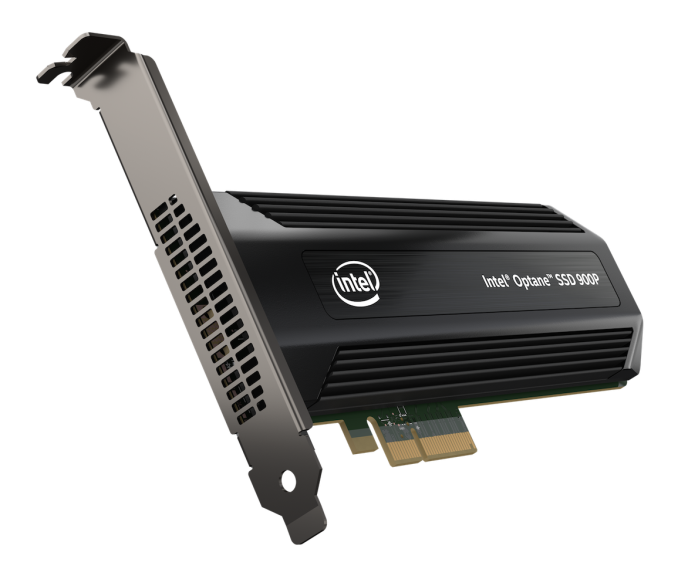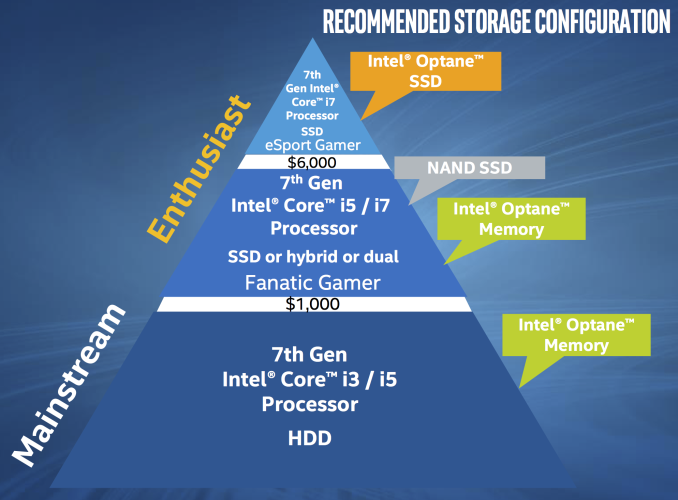The Intel Optane SSD 900P 280GB Review
by Billy Tallis on October 27, 2017 9:30 AM EST
Whenever Intel develops a new generation of SSDs based entirely on in-house technology, the result is usually a product that turns heads. Several times, Intel has set a new standard for SSD performance, starting with its original X25-M. Their most recent shake-up of the consumer SSD market was the Intel SSD 750, the first consumer NVMe SSD. Such significant releases don't happen every year, and in the intervening years Intel's competitors always catch up and surpass Intel.
However this year's revolution from Intel will be very hard for the competition to match anytime soon. All of Intel's previous record-setting SSDs have relied on the drive's controller to stand out from the crowd. This time, Intel's advantage comes from the storage medium: its 3D XPoint memory technology, a new nonvolatile memory that offers much higher performance than flash memory.
The Intel Optane SSD 900P
The new Intel Optane SSD 900P is a premium NVMe PCIe SSD offering the highest level of performance, with a moderate capacity. The Optane SSD 900P is intended for high-end desktop systems and workstations with very disk-heavy workloads. The Optane SSD 900P isn't for everyone and won't be displacing any existing products - it exists alone in a new product tier, with prices that are more than twice what the fastest flash memory based SSDs are selling for.
Optane is Intel's brand name for products featuring 3D XPoint memory. The Intel Optane SSD 900P is actually the third Optane product to be released, but it's the first family member to go after the high end consumer market segment. The Intel Optane Memory M.2 drives released earlier this year have capacities far too small for general-purpose storage use and instead have been marketed for use as a cache device to be paired with a mechanical hard drive. Intel's caching strategy works and can bring a hard drive's responsiveness up to the level of mainstream SSDs, but it has downsides. The Optane Memory caching requires a few extra steps to setup, and the caching software will only run on Intel platforms introduced this year: Kaby Lake or newer.
The Optane SSD DC P4800X is Intel's flagship enterprise SSD, and it is priced accordingly—putting it far out of reach of consumer budgets, and even with a price tag of over $1500 for 375GB it has been quite difficult to acquire. In the enterprise storage market, the P4800X has been highly sought after, but it isn't appropriate for all use cases and is not a threat to the many enterprise SSDs that prioritize capacity over performance and endurance.
The Optane SSD 900P will still cause some sticker shock for consumers expecting prices in line with M.2 PCIe SSDs, but it is acceptable for the kinds of machines that might be packing multiple GPUs or 10+ CPU cores. The Optane SSD 900P probably wouldn't be the only drive in such a system, but it would work well as a blazing fast primary storage device.
| Intel Optane SSD 900P Specifications | ||
| Capacity | 280 GB | 480 GB |
| Controller | Intel SLL3D | |
| Memory | Intel 128Gb 3D XPoint | |
| Interface | PCIe 3.0 x4 | |
| Form Factor | HHHL Add-in card or 2.5" 15mm U.2 |
HHHL Add-in card |
| Sequential Read | 2500 MB/s | |
| Sequential Write | 2000 MB/s | |
| Random Read IOPS | 550k | |
| Random Write IOPS | 500k | |
| Power Consumption | 8W Read 13W Write 14W Burst 5W Idle |
|
| Write Endurance | 10 DWPD | |
| Warranty | 5 years | |
| Recommended Price | $389 ($1.39/GB) | $599 ($1.25/GB) |
The Intel Optane SSD 900P is initially launching with 280GB and 480GB capacities. Both sizes will be available as PCIe 3.0 x4 half-height half-length add-in cards, and the 280GB model is also available as a 2.5" U.2 drive. Higher capacities may be added later, but Intel isn't promising anything yet. The sequential transfer speeds are nothing special for a NVMe SSD these days—Samsung's 960 PRO can hit much higher read speeds and slightly higher write speeds. The random read and write IOPS are far higher than any consumer SSD has offered before.
Intel's specifications for power consumption show one big reason why the Optane SSD 900P is a desktop-only product. Laptops are not equipped to supply up to 14W to a SSD, and they usually aren't equipped to cool a drive that idles at 5W instead of 50mW. The level of performance offered by the Optane SSD 900P cannot currently fit within the power budget or space constraints of a M.2 card.
The five year warranty Intel offers is typical for a high-end SSD in today's market, but doesn't compare to the 10 year warranty that Samsung's flagship 850 PRO SATA SSD offers. On the other hand, the 10 drive writes per day write endurance rating is far higher than most consumer SSDs get; 0.3 DWPD is more typical.
The Intel Optane SSD 900P starts shipping worldwide today, and here is our review of the 280GB version.











205 Comments
View All Comments
Hurr Durr - Friday, October 27, 2017 - link
He desperately needs some CNC time to calm down, be merciful.Reflex - Friday, October 27, 2017 - link
We need to compile a list of all the things you supposedly have been doing. I mean seriously, anything anyone brings up as a use case supposedly you've been doing forever at a professional level. And you use that imagined position to then attempt to clobber their own assertions about its applicability in the field they are discussing.ddriver - Friday, October 27, 2017 - link
What can I say, I am a renaissance man. Also known as a polymath. I have scores of interests in all sorts of fields or science, arts and crafts, and I have employed many of those to make a living over the years. Where you collect pokemons, or postal stamps, or baseball hats or whatever, I collect skill and knowledge. Even the act of commenting here is part of my studies, social and psychological.Reflex - Friday, October 27, 2017 - link
Not only have you pursued your 'scores' of interests, you are the expert in all of them! We are truly gifted by your presence, I cannot wait to read your memoirs....MarceloC - Friday, October 27, 2017 - link
"What can I say, I am a renaissance man. Also known as a polymath. I have scores of interests in all sorts of fields or science, arts and crafts, and I have employed many of those to make a living over the years. Where you collect pokemons, or postal stamps, or baseball hats or whatever, I collect skill and knowledge. Even the act of commenting here is part of my studies, social and psychological."LOL LOL LOL!
sor - Friday, October 27, 2017 - link
You clearly don’t care about immediate persistence, consistent performance, or random reads.The numbers make a clear argument that Optane won’t be all that helpful for light workloads, but we already expected that; there’s only so much super fast IO can do for you if you’re not using IO.
I’d say those insane random reads and improved latencies live up to 3D Xpoint. There may be some elements to improve on but it is clear we are looking at a different, superior tech at a cost that is surprisingly affordable. Much of the initial talk about Xpoint was around whether or not it was real, if it was a hyped twist on regular flash, it seems clear it is a different animal.
ddriver - Friday, October 27, 2017 - link
You clearly didn't pay attention to what I've written. I did indeed acknowledge the random reads as an obviously strong point.Judging by the "destroyer", it won't be that helpful in heavy workloads either. In fact, contrary to what you say, where it shines the most is exactly light workloads, which is what low QDs are. Push higher queue depths and NVME catches up.
Lolimaster - Saturday, October 28, 2017 - link
With most work using big files, 4k random performance is meaningless, everything is linear so huge sustained write/reads are prefered. 960EVO/Pro wins.ionstorm66 - Sunday, October 29, 2017 - link
I wonder how much more performance that same test system would get if it had 128GB of ram. The 900P 280GB is 389 bucks, 64GB kit of ram is 500 bucks. I'd take 64GB of system memory over 280gb of ssd storage anyday, especially with a system with a 960 pro already.mapesdhs - Tuesday, October 31, 2017 - link
Unless of course you're doing something that needs ECC, in which case that cost comparison is rather wide of the mark.